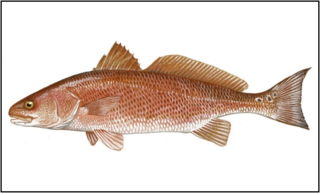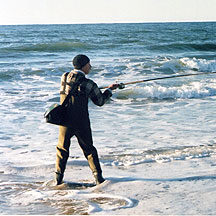
The largemouth bass is a carnivorous freshwater ray-finned fish in the Centrarchidae (sunfish) family, native to the eastern and central United States, southeastern Canada and northern Mexico. It is known by a variety of regional names, such as the widemouth bass, bigmouth bass, black bass, bucketmouth, largie, Potter's fish, Florida bass, Florida largemouth, green bass, bucketmouth bass, green trout, Gilsdorf bass, Oswego bass, LMB, and southern largemouth and northern largemouth.

Angling is a fishing technique that uses a fish hook attached to a fishing line to tether individual fish in the mouth. The fishing line is usually manipulated via a fishing rod, although rodless techniques such as handlining also exist. Modern angling rods are usually fitted with a fishing reel that functions as a cranking device for storing, retrieving and releasing out the line, although Tenkara fishing and traditional cane pole fishing are two rod-angling methods that do not use any reel. The fish hook itself can be additionally weighted with a denser tackle called a sinker, and is typically dressed with an appetizing bait to attract and entice the fish into swallowing the hook, but sometimes an inedible fake/imitation bait with multiple attached hooks is used instead of a single hook with edible bait. Some type of bite indicator, such as a float, a bell or a quiver tip, is often used to relay underwater status of the hook to the surface and alert the angler of a fish's presence.

A fishing lure is any one of a broad category of artificial angling baits that are inedible replicas designed to mimic prey animals that attract the attention of predatory fish, typically via appearances, flashy colors, bright reflections, movements, vibrations and/or loud noises which appeal to the fish's predation instinct and entice it into gulping the lure. Angling activities using lures are known as lure fishing.
Lake Houston is a reservoir on the San Jacinto River, 15 miles (24 km) northeast of downtown Houston, Texas, United States. The reservoir is the primary municipal water supply for the city of Houston.

The chain pickerel is a species of freshwater fish in the pike family of order Esociformes. The chain pickerel and the American pickerel belong to the Esox genus of pike.

The black crappie is a freshwater fish found in North America, one of the two types of crappies. It is very similar to the white crappie in size, shape, and habits, except that it is darker, with a pattern of black spots.

The red drum, also known as redfish, channel bass, puppy drum, spottail bass, or simply red, is a game fish found in the Atlantic Ocean from Massachusetts to Florida and in the Gulf of Mexico from Florida to northern Mexico. It is the only species in the genus Sciaenops.

A fishing sinker or knoch is a weight used in conjunction with a fishing lure or hook to increase its rate of sink, anchoring ability, and/or casting distance. Fishing sinkers may be as small as 1 gram (0.035 oz) for applications in shallow water, and even smaller for fly fishing applications, or as large as several pounds or considerably more for deep sea fishing. They are formed into many different shapes for diverse fishing applications. Environmental concerns surround the usage of lead and other materials in fishing sinkers.

The Texas rig is a fishing rig used for angling with soft plastic lures.
Averhoff Reservoir is a 173-acre narrow, riverine-type reservoir located on the Nueces River 10 mi (16 km) north of the town of Crystal City in Zavala County, Texas, United States, and 100 miles from San Antonio, Texas.

The John H. Kerr Reservoir is a reservoir along the border of the U.S. states of North Carolina and Virginia. The U.S. Army Corps of Engineers constructed the John H. Kerr Dam across the Roanoke River between 1947 and 1952 to produce hydroelectricity as well as for flood control. Kerr Lake is the largest lake in Virginia, with 850 miles (1,370 km) of shoreline located in Vance, Granville, and Warren counties in North Carolina, as well as Mecklenburg, Charlotte, and Halifax counties in Virginia. At its maximum capacity, it covers approximately 50,000 acres (200 km2) and is one of the largest reservoirs in the Southeastern United States. The name honors its Congressional sponsor, John H. Kerr, a North Carolina Democrat who supported creation of the lake. The lake supports recreational tourism in North Carolina and Virginia as described below.

Fishing tackle is the equipment used by anglers when fishing. Almost any equipment or gear used in fishing can be called fishing tackle, examples being hooks, lines, baits/lures, rods, reels, floats, sinkers/feeders, nets, spears, gaffs and traps, as well as wires, snaps, beads, spoons, blades, spinners, clevises and tools that make it easy to tie knots.

A plastic worm or trout worm is a soft-bodied fishing lure made of elastomer polymer material, generally simulating an earthworm. Plastic worms are typically impaled onto a hook, and can carry a variety of shapes, colors and sizes, awith some are even scented to simulate live bait.

Soft plastic bait, commonly known as soft lure, soft plastics, plastic bait, worm lure or just worm, is any of a range of elastomer-based fishing lures termed so because of their flexible, flesh-like texture. Soft lures are available in a large range of colours, sizes and particularly shapes, and are typically impaled directly onto a fishing hook like an ordinary bait.

Surf fishing is land-based game fishing while standing on the shoreline or wading into the surf zone. A general term, surf fishing may or may not include casting a lure or bait, and refers to all types of shore fishing – from sandy and rocky beaches, rock jetties, or even fishing piers. The terms surfcasting or beachcasting refer more specifically to surf fishing from the beach by casting into the surf at or near the shoreline. With few exceptions, surf fishing is done in saltwater. The most common misconception about surf fishing is the idea that one must cast as far out as possible in order to reach the fish. At beaches on the west coast of the United States, and in fact, at most beaches around the world, you only really need to get your bait into knee-deep water. This is referred to as surf fishing the "skinny".
Drop shotting is a highly finesse angling technique using plastic baits, consisting of a small thin-wire hook with a weight (sinker) attached to the tag end of the line. This is in contrast to the more traditional Texas Rig, where the weight slides inline, resting on the nose of the bait; or the Carolina Rig, where the weight is fixed above the bait. The dropshot rig provides the ability to keep a hook and lure off the bottom with a more "weightless"-looking posture. Usually the bait is fished by letting the weight hit the bottom and then twitch the rod tip, causing the lure to shake in a jumping-like action, but can also be flipped, dragged, hopped or jigged along the bottom. This simple but versatile technique has endless combinations with the different hooks, soft plastics and weights that can be used.[1] The aim is to present a free floating, slow twitching lure to induce a strike from non-aggressive fish. This rig is commonly used in bass fishing for catching smallmouth, largemouth and spotted bass, but can be used for a variety of other bottom-dwelling fish species, as well.
This page is a list of fishing topics.
The following outline is provided as an overview of and topical guide to fishing:

A rig is an arrangement of items used for fishing. It can be assembled of one or more lines, hooks, sinkers, bobbers, swivels, lures, beads, and other fishing tackle. A rig might be held by a rod, by hand, or attached to a boat or pier. Some rigs are designed to float near the surface of the water, others are designed to sink to the bottom. Some rigs are designed for trolling. Many rigs are designed especially for catching a single species of fish, but will work well for many different species.
The wacky rig is a skill technique used for fishing with a soft plastic lure, such as the Gary Yamamoto 'Senko'. Notable for its unique action even among soft lures, wacky style is used to heighten the chance at catching finicky fish on harsh days, although at the expense of lowering the chances of very large fish, because the size of the bait is very small, allowing bass of all sizes to take the bait. Unlike the Texas rig and Carolina rig, both sides of the wacky rig flutter, creating a more natural action. The name comes from its unusual style of attaching a plastic worm through the middle of the body instead of on one end.















